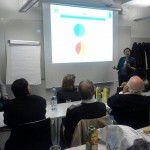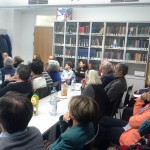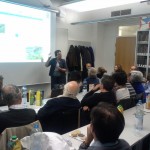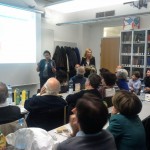«اکوسیستمهای جنگلی منطقه رویشی زاگرس»
دکتر سودابه علیاحمد کروری – مستان • ۱۴ مهر ۱۳۹۷ • دانش • دستهبندی نشده • مجله اینترنتی • گزارش فعالیتهای کانونسخنران: خانم دکتر سودابه علیاحمد کروری – مستان
زمان: چهارشنبه ۲۶ سپتامبر ۲۰۱۸ میلادی
چکیده
این مقاله پس از ذکر تاریخ مختصری در ارتباط با جنگلهای زاگرس، روی شرایط موجود جنگلهای بلوط ایلام و ارزیابی پتانسیلهای منفی و مثبت استان مذکور، در راستای نجات جنگلهای باقیمانده زاگرس، از جمله جنگلهای بلوط متمرکز شده است. روش پیشنهادی در این راستا، اجرای مدیریت جنگل در درون اکوسیستم، از جمله با نگرش دریافت همکاریهای مردم ساکن در اکوسیستم است. مطالعات اجتماعی ما گویای بدبینی همراه با اندکی زیاده خواهی بعضی از ساکنین اکوسیستمهای طبیعی است. اجرای این نوع مدیریت فقط با لحاظ برنامههای اقتصادی همگن با تنوع زیستی منطقه امکان پذیر است. این مطالعات بر لزوم تخصیص مناطق مناسب جهت انجام مطالعات پایش نیز تاکید کرده است. نتایج مطالعات بیولوژیک روی بستر ثابت کرده است که با وجود تخریب زیاد، هنوز بسیاری از مناطق جنگلهای ایلام قابل احیا هستند. پژوهش پیش رو، ضمن بیان خلاصهای در ارتباط با شرایط موجود جنگلهای ایلام، ابتدا روی علل مرگ بلوطهای زاگرس متمرکز شده است.این مهم در دو بخش انسانی، گیاهی و بیولوژیک بستر حیات، در محدوده اجرای پروژه به مطالعه پرداخته است. این بررسیها در درجه اول، عدم تدوین و اجرای مدیریت اکوسیستمی را به عنوان عامل اصلی تخریب شدید جنگلهای زاگرس از جمله مرگ بلوط معرفی کرده است (به هم خوردن چرخه حیات و فرایند همزیستی بین اعضا سیستم)، در نتیجه بروز ضعف شدید فیزیولوژی در سیستم بیولوژی از جمله درختان بلوط). این نتایج نقش تغییرات اقلیم از جمله کاهش بارندگی، وجود ریزگردها و تداوم جنگ در مرزهای زاگرس را به عنوان تنشهای ثانویه در این امر ثابت کرده است. پژوهشهای گسترده اخیر خوشبختانه ثابت میکند برخلاف بعضی از تئوریهای مطرح شده، بلوطهای زاگرس هنوز هم از تنوع درون گونهای بالایی برخوردارند. نتایجاین پژوهش معرف اثر منفی اجرای مدیریت اگروفارستری در عرصههای جنگلهای زاگرس است. بتدریج با کاهش توان درون گونهای، موجب انقراض کل جنگل خواهد شد. طبیعی است که ادامه این سیاست، ما را با چالشی حادتر از امروز در زاگرس رو برو خواهد نمود. نتایج مطالعات اجتماعی اقتصادی بیانگر مهاجرت وسیع روستاییان به شهرهای بزرگ، هرم منفی سن روستائیان به دلیل کاهش تمایل به اولادآوری بیشتر،در مقابل گویای علاقه بیشتر به ادامه تحصیلات حتی در مقاطع دانشگاهی میباشد. ضمنا منشاء گذران زندگی و مالی اهالی بیشتر از طریق دامداری است. کاهش علاقه مردم از جمله زنان به تولید صنایع دستی قابل توجه میباشد.
کلمات کلید: احیاء جنگل، اقتصاد پایدار، اکوفیزیولوژی، اگروفارستری، ایلام، ژنتیک، مدیریت اکوسیستم، مردم، نقشه راه
تذکر مهم: معمولا تعداد کلمات کلیدی حدود پنج تا است. نظر با نکه این مقاله بیانگر چند مقاله پژوهشی به صورت خلاصه می باشد، از کلمات کلیدی بیشتری نیز استفاده شده است.
Genetic diversity of Quercus persica in southern Zagros, the site facing widespread oak decline, and effect of heavy metals contamination on this mortality
Background
Oak mortality of Zagros forests has been increasingly reported,especially in the last five years, and is turning into a disaster for Iran’s plant diversity (Ebrahimi Rostaghi 2010). There are lots of hypothesis addressing the Persian Oak decline, in which following reasons mentioned as main involvement factors, genetic erosion (according to the similar condition in the Oak forests in Europe and the United States, Brown and Davis 1991), bacterial and/or fungal diseases due to thephysiological weakness (also probably because of an inappropriate management), and changes in the annual precipitation as a consequence of global climate change (Hosseini 2011, Jowzian and Abaeie 2011, Tahmasbipour and Beyranvand 2012, Mirabolfathi 2013). In recent years, dust storms coming from western neighboring countries are drastically increased and affecting western and even central part of Iran. This phenomenon is caused a lot of environmental and socio-economic problems (Geravini et al., 2001). The main cause of dust creating in the Middle East, is a global droughts and annual precipitation decreases. Loss of vegetation and desertification in Iraq, are from other causes. Equally important is the prevention and management of this phenomenon (Aminipour et al., 1999). A studies revealed the strong winter Shamal leads to dust emission over Syria and Iraq as well as the transport of dust over Iraq and northwest of Iran (Aber et al., 2002). There is a possibility of dust contamination with chemical, biological and radioactive factors. For example, the amount of elements like uranium, thorium, arsenic, lead, zinc, nickel and cobalt in these samples is slightly higher than normal. Given the frequent use of biological weapons, chemical and depleted uranium by the Iraq war and America is not surprised this pollution (Aminipour et al., 1999). However, high concentration of heavy metals cause damages and destruction in trees which is differ from the species to species and even a stand to other stand as well as from a heavy metal to others.
Material and methods
Current study conducted in Ilam province in the west of Iran, where Quercus persicais native to the Zagros forests, and the highest mortality rate was observed in this area.The main concern of this project was to address the oak decline of Zagros forests of Iran. Four sites in Ilam province selected in different districts (P1, P2, P3 and P4). Then, in each site the leaves samples selected from 72 different phenotypes include healthy stands (phenotype A), semi-healthy stands (phenotype B), more than 80 percent damaged stands (phenotype C) for investigation of genetic diversity (as part A). As well as, soil samples gathered from four depth ranges of 3-10, 10-30, 30-50, and 50-80 cm in each studied site. Concentration of the four heavy metals Zn, Pb, Cd and Ni were determined by ICP instrument (as part B). Standard reference material was used for control Pine Needles (NIST 1575) and Apple leaves (NIST ۱۵۱۵) from National Institute of Standards and Technology, Gaithersburg, USA.
Findings
Part A)the genetic diversity estimated using 12 SSR (microsatellite) markers. The ssrQPZAG1-5 and ssrQPZAG119 indicated the highest and lowest number of polymorphic bands, respectively. Totally, 124 bands were amplified in which 107 bands were polymorph. The result demonstrated a high genetic diversity among selected individuals of various phenotypes. The highest number and percentage of polymorphic bands were 30 and 96.77 %, which observed in the fourth population (Ilam city plot). In contrast, the minimum number and percentage recorded in the third population (Eivan plot) by 24, and 77.42 %, respectively. Moreover, a positive values of heterozygosity (Ht) across the entire trees provides valuable genetic resources to help improve the suitability of the oak forests.
Part B)Results indicated that, the highest concentration of Ni, Pb, Zn and Cd observed in the soil of P3, P4, P4 and P1, respectively. Although, the highest amount of heavy metals measured in the depth ranges of ۳-۵۰ cm, it showed fluctuation from 3 to 80 cm, considerably. However, phenotype A and phenotype B contained the highest heavy metals in the whole areas. The results showed that, severity of damages to the forest ecosystem andmortality of Oak stands in the border region of Anaarak (P4) was more than other studied areas.Our result suggest that, healthy trees has high phytoremediation due to physiological capability in reduction, storage, transformation, and stabilization of heavy metals.
References
Aber JS, Wallace J, Nowak M C (2002) Response of forest to climatic events and human management at Fort Leavenworth. Kanas, Current Research in Bulletin 248: 1-24.
Aminipour B, jalali N, Nowruzi A, Abkari A, Zare Mayvan H (1999) Spatial tracing of the smog and oil spills resulted from burning of Kuwait oil wells. The quarterly Pazhuhesh va Sazandegi of Iran 43: 137- 139.
Brown R, Davis F (1991) Historical Mortality of Valley Oak (Quercus lobata, Nee) in the Santa Ynez Valley, Santa Barbara County, 1938-19891. USDA Forest Service Gene, 126: 202-207.
Ebrahimi Rostaghi M (2010) The current dimensions of biodiversity threads in Central Zagros of Iran with emphasis on the forest cover. In compilation of the first national convention on the threats and the main issues of degradation of natural resources in the central Zagros, the Technical University of Isfahan. Printed in Persian.
Geravini H, Lashkaripour Gh. R, Ghafoori M, Jalali N (2001) The Source of Dust Storm in Iran: A case study based on geological information and rainfall data. Carpathian Journal of Earth and Environmental Sciences. 6 (10): 297-308.
Geravini, H., Lashkaripour, Gh. R., Ghafoori, M. and Jalali, N. 2001. The Source of Dust Storm in Iran: A case study based on geological information and rainfall data. Carpathian Journal of Earth and Environmental Sciences. 6 (10): 297-308.
Hosseini A (2011) Evaluation of the tree contaminations to the wood- boring beetles and their correlation with the site condition in Quercus branti Forests of Ilam province in Iran. The quarterly of Protection and Conservation of Forests and Rangelands of Iran 9 (1): 53 – ۶۶٫ Printed in Persian.
Jowzian A Abaeie M (2011) Burst of Agrilus hastulifer under recent drought conditions of the forests of Ilam province in: the national convention of the central Zagros forests of Iran, potentials and constraints, Khoramabad, December 2011. Printed in Persian.
Mirabolfathi M (2013) Outbreak of charchol disease on Quercus spp and Zelkova carpinifolia trees forests Zagros. Iranian Plant Pathology 49: 77-79.
Tahmasbipour N, Beyranvand A (2012) Evaluation of the dust catastrophe in western Iran, case study: Fars province. In: the first national convention of environmental and natural resources policies of Zagros, Khorramabad, the crisis management organization of Lorestan Province.






